Annotated Bibliography: Social Worker's Role in Child Protection
VerifiedAdded on 2023/04/04
|30
|6174
|371
Annotated Bibliography
AI Summary
This annotated bibliography examines the role of social workers in the protection of children, particularly those affected by domestic violence. The bibliography includes eight entries, each providing a full citation, a summary of the author's purpose, a brief overview of the content including research methodology and participant information, an evaluation of the content, and a reflection on the usefulness of the source. The sources reviewed cover a range of topics, including the impact of domestic violence on children, the effectiveness of perpetrator programs, the role of social workers in intervention, and the challenges faced in practice. The research methodology and participant information is described for each source, including study designs, sample sizes, and key findings related to the effects of domestic violence and the need for effective child protection strategies. The evaluations assess the strengths and limitations of each source, considering factors such as methodology, sample size, and relevance to the research topic. The bibliography highlights the importance of understanding the complexities of domestic violence and its impact on children and the role of social workers in providing support and intervention. The reflection sections discuss the relevance of the sources to the broader field of social work and child protection. The document also includes an abstract, a table of contents, and an introduction that outlines the research topic, objectives, and questions. It also includes a research methodology section with details on data collection, sampling, and analysis, as well as budget and ethical considerations. A questionnaire is also included as an appendix.

Running Head: ROLE OF SOCIAL WORKER IN PROTECTION OF CHLDREN
Role of Social Worker in Protection of Children
Name of Student
Name of University
Author Note
Role of Social Worker in Protection of Children
Name of Student
Name of University
Author Note
Paraphrase This Document
Need a fresh take? Get an instant paraphrase of this document with our AI Paraphraser

1ROLE OF SOCIAL WORKER IN PROTECTION OF CHLDREN
Annotated Bibliography
Chappell, L., & Curtin, J. (2013). Does federalism matter? Evaluating state architecture
and family and domestic violence policy in Australia and New Zealand. Publius: The
Journal of Federalism, 43(1), 24-43.
This article deals with the question of policy and legislations in the area of domestic
violence and family violence. The study compares the statistics of Australia and New
Zealand, because of their federal structures are similar. The study also states that Australia
has included many innovative policies to combat the evil of domestic abuse. The article also
states the importance of federal policies in matters of domestic violence; it states that in order
safeguard the victim from further humiliation proper policies have to be in place.
This study is important because every victim needs to know the laws that can protect
them, if the perpetrators know that there is a consequence to his/her actions the rate of the
crime might decrease. The family can take the help of the law enforcement officers to give
the victim their desired outcome.
Schiff, M., Plotnikova, M., Dingle, K., Williams, G. M., Najman, J., & Clavarino, A.
(2014). Does adolescent's exposure to parental intimate partner conflict and violence
predict psychological distress and substance use in young adulthood? A longitudinal
study. Child abuse & neglect, 38(12), 1945-1954.
This report studies whether inter partner conflict or violence causes depression among
the offspring. It not only focuses on the depression but also on substance abuse. The articles
talk about the fact the when a child witnesses domestic abuse at a young age, it leads to
depression or a habit of drug abuse in the adolescent years. The study has been done by
taking large scale primary data from 2126 mother and their children.
Annotated Bibliography
Chappell, L., & Curtin, J. (2013). Does federalism matter? Evaluating state architecture
and family and domestic violence policy in Australia and New Zealand. Publius: The
Journal of Federalism, 43(1), 24-43.
This article deals with the question of policy and legislations in the area of domestic
violence and family violence. The study compares the statistics of Australia and New
Zealand, because of their federal structures are similar. The study also states that Australia
has included many innovative policies to combat the evil of domestic abuse. The article also
states the importance of federal policies in matters of domestic violence; it states that in order
safeguard the victim from further humiliation proper policies have to be in place.
This study is important because every victim needs to know the laws that can protect
them, if the perpetrators know that there is a consequence to his/her actions the rate of the
crime might decrease. The family can take the help of the law enforcement officers to give
the victim their desired outcome.
Schiff, M., Plotnikova, M., Dingle, K., Williams, G. M., Najman, J., & Clavarino, A.
(2014). Does adolescent's exposure to parental intimate partner conflict and violence
predict psychological distress and substance use in young adulthood? A longitudinal
study. Child abuse & neglect, 38(12), 1945-1954.
This report studies whether inter partner conflict or violence causes depression among
the offspring. It not only focuses on the depression but also on substance abuse. The articles
talk about the fact the when a child witnesses domestic abuse at a young age, it leads to
depression or a habit of drug abuse in the adolescent years. The study has been done by
taking large scale primary data from 2126 mother and their children.
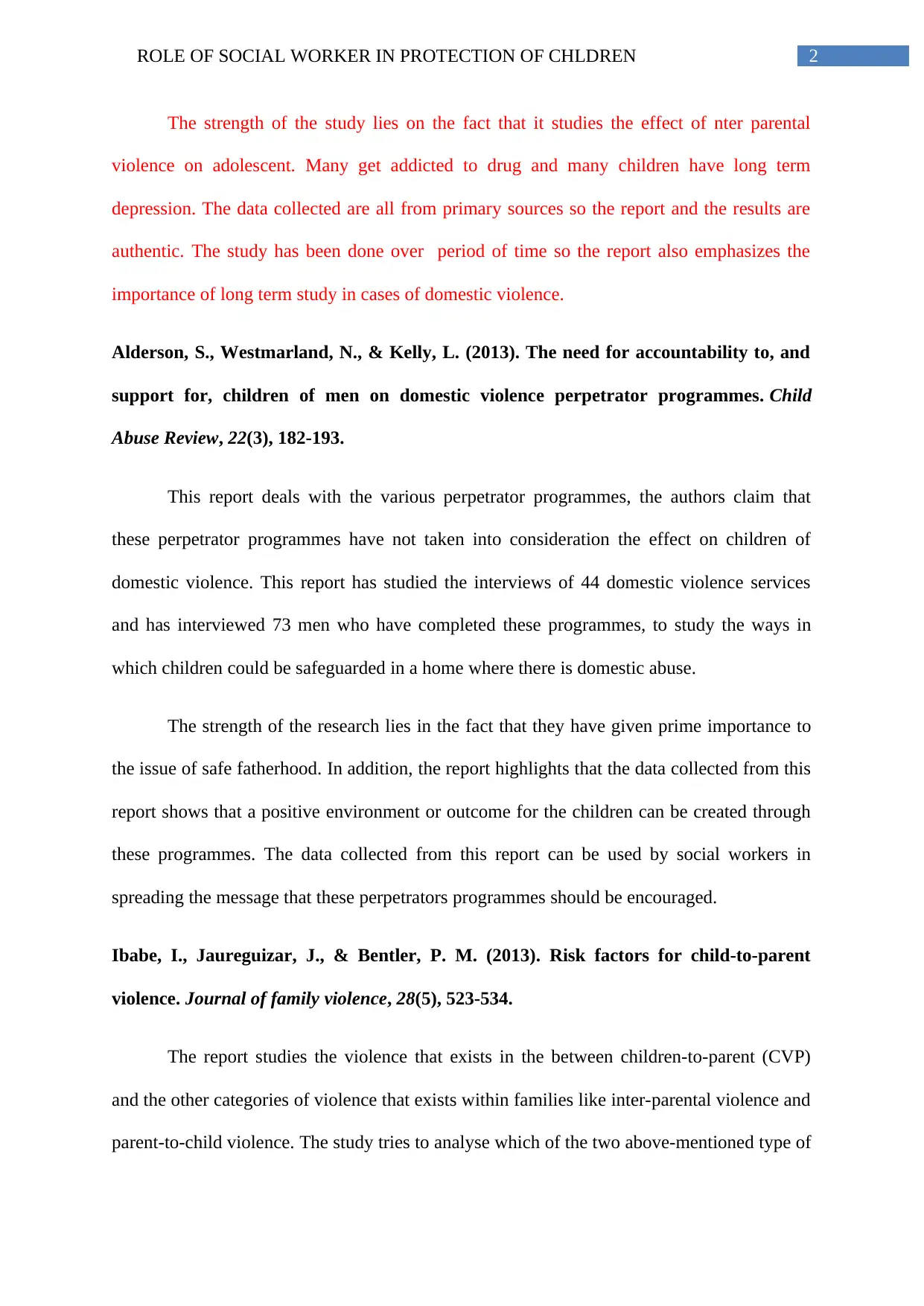
2ROLE OF SOCIAL WORKER IN PROTECTION OF CHLDREN
The strength of the study lies on the fact that it studies the effect of nter parental
violence on adolescent. Many get addicted to drug and many children have long term
depression. The data collected are all from primary sources so the report and the results are
authentic. The study has been done over period of time so the report also emphasizes the
importance of long term study in cases of domestic violence.
Alderson, S., Westmarland, N., & Kelly, L. (2013). The need for accountability to, and
support for, children of men on domestic violence perpetrator programmes. Child
Abuse Review, 22(3), 182-193.
This report deals with the various perpetrator programmes, the authors claim that
these perpetrator programmes have not taken into consideration the effect on children of
domestic violence. This report has studied the interviews of 44 domestic violence services
and has interviewed 73 men who have completed these programmes, to study the ways in
which children could be safeguarded in a home where there is domestic abuse.
The strength of the research lies in the fact that they have given prime importance to
the issue of safe fatherhood. In addition, the report highlights that the data collected from this
report shows that a positive environment or outcome for the children can be created through
these programmes. The data collected from this report can be used by social workers in
spreading the message that these perpetrators programmes should be encouraged.
Ibabe, I., Jaureguizar, J., & Bentler, P. M. (2013). Risk factors for child-to-parent
violence. Journal of family violence, 28(5), 523-534.
The report studies the violence that exists in the between children-to-parent (CVP)
and the other categories of violence that exists within families like inter-parental violence and
parent-to-child violence. The study tries to analyse which of the two above-mentioned type of
The strength of the study lies on the fact that it studies the effect of nter parental
violence on adolescent. Many get addicted to drug and many children have long term
depression. The data collected are all from primary sources so the report and the results are
authentic. The study has been done over period of time so the report also emphasizes the
importance of long term study in cases of domestic violence.
Alderson, S., Westmarland, N., & Kelly, L. (2013). The need for accountability to, and
support for, children of men on domestic violence perpetrator programmes. Child
Abuse Review, 22(3), 182-193.
This report deals with the various perpetrator programmes, the authors claim that
these perpetrator programmes have not taken into consideration the effect on children of
domestic violence. This report has studied the interviews of 44 domestic violence services
and has interviewed 73 men who have completed these programmes, to study the ways in
which children could be safeguarded in a home where there is domestic abuse.
The strength of the research lies in the fact that they have given prime importance to
the issue of safe fatherhood. In addition, the report highlights that the data collected from this
report shows that a positive environment or outcome for the children can be created through
these programmes. The data collected from this report can be used by social workers in
spreading the message that these perpetrators programmes should be encouraged.
Ibabe, I., Jaureguizar, J., & Bentler, P. M. (2013). Risk factors for child-to-parent
violence. Journal of family violence, 28(5), 523-534.
The report studies the violence that exists in the between children-to-parent (CVP)
and the other categories of violence that exists within families like inter-parental violence and
parent-to-child violence. The study tries to analyse which of the two above-mentioned type of
⊘ This is a preview!⊘
Do you want full access?
Subscribe today to unlock all pages.

Trusted by 1+ million students worldwide
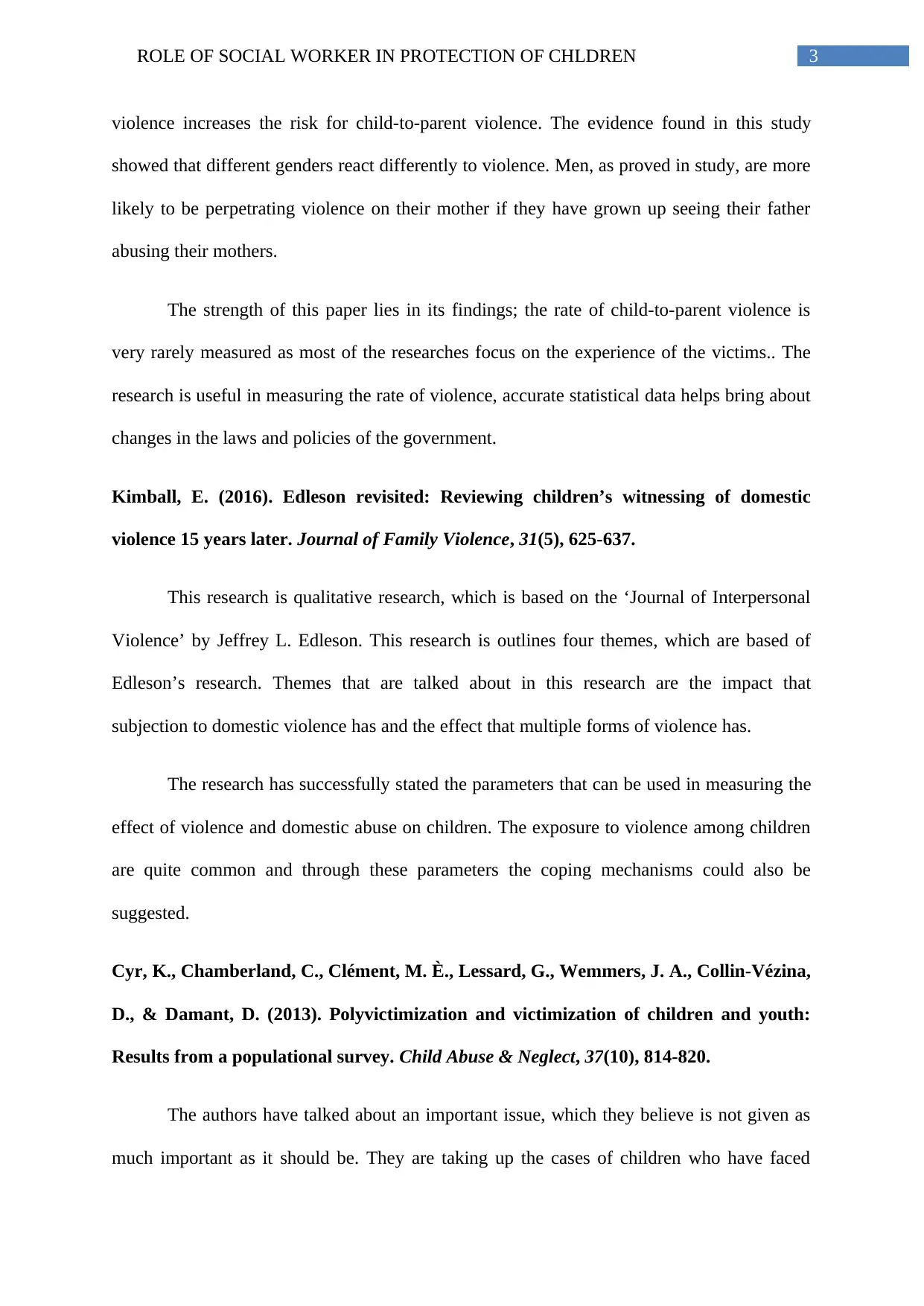
3ROLE OF SOCIAL WORKER IN PROTECTION OF CHLDREN
violence increases the risk for child-to-parent violence. The evidence found in this study
showed that different genders react differently to violence. Men, as proved in study, are more
likely to be perpetrating violence on their mother if they have grown up seeing their father
abusing their mothers.
The strength of this paper lies in its findings; the rate of child-to-parent violence is
very rarely measured as most of the researches focus on the experience of the victims.. The
research is useful in measuring the rate of violence, accurate statistical data helps bring about
changes in the laws and policies of the government.
Kimball, E. (2016). Edleson revisited: Reviewing children’s witnessing of domestic
violence 15 years later. Journal of Family Violence, 31(5), 625-637.
This research is qualitative research, which is based on the ‘Journal of Interpersonal
Violence’ by Jeffrey L. Edleson. This research is outlines four themes, which are based of
Edleson’s research. Themes that are talked about in this research are the impact that
subjection to domestic violence has and the effect that multiple forms of violence has.
The research has successfully stated the parameters that can be used in measuring the
effect of violence and domestic abuse on children. The exposure to violence among children
are quite common and through these parameters the coping mechanisms could also be
suggested.
Cyr, K., Chamberland, C., Clément, M. È., Lessard, G., Wemmers, J. A., Collin-Vézina,
D., & Damant, D. (2013). Polyvictimization and victimization of children and youth:
Results from a populational survey. Child Abuse & Neglect, 37(10), 814-820.
The authors have talked about an important issue, which they believe is not given as
much important as it should be. They are taking up the cases of children who have faced
violence increases the risk for child-to-parent violence. The evidence found in this study
showed that different genders react differently to violence. Men, as proved in study, are more
likely to be perpetrating violence on their mother if they have grown up seeing their father
abusing their mothers.
The strength of this paper lies in its findings; the rate of child-to-parent violence is
very rarely measured as most of the researches focus on the experience of the victims.. The
research is useful in measuring the rate of violence, accurate statistical data helps bring about
changes in the laws and policies of the government.
Kimball, E. (2016). Edleson revisited: Reviewing children’s witnessing of domestic
violence 15 years later. Journal of Family Violence, 31(5), 625-637.
This research is qualitative research, which is based on the ‘Journal of Interpersonal
Violence’ by Jeffrey L. Edleson. This research is outlines four themes, which are based of
Edleson’s research. Themes that are talked about in this research are the impact that
subjection to domestic violence has and the effect that multiple forms of violence has.
The research has successfully stated the parameters that can be used in measuring the
effect of violence and domestic abuse on children. The exposure to violence among children
are quite common and through these parameters the coping mechanisms could also be
suggested.
Cyr, K., Chamberland, C., Clément, M. È., Lessard, G., Wemmers, J. A., Collin-Vézina,
D., & Damant, D. (2013). Polyvictimization and victimization of children and youth:
Results from a populational survey. Child Abuse & Neglect, 37(10), 814-820.
The authors have talked about an important issue, which they believe is not given as
much important as it should be. They are taking up the cases of children who have faced
Paraphrase This Document
Need a fresh take? Get an instant paraphrase of this document with our AI Paraphraser
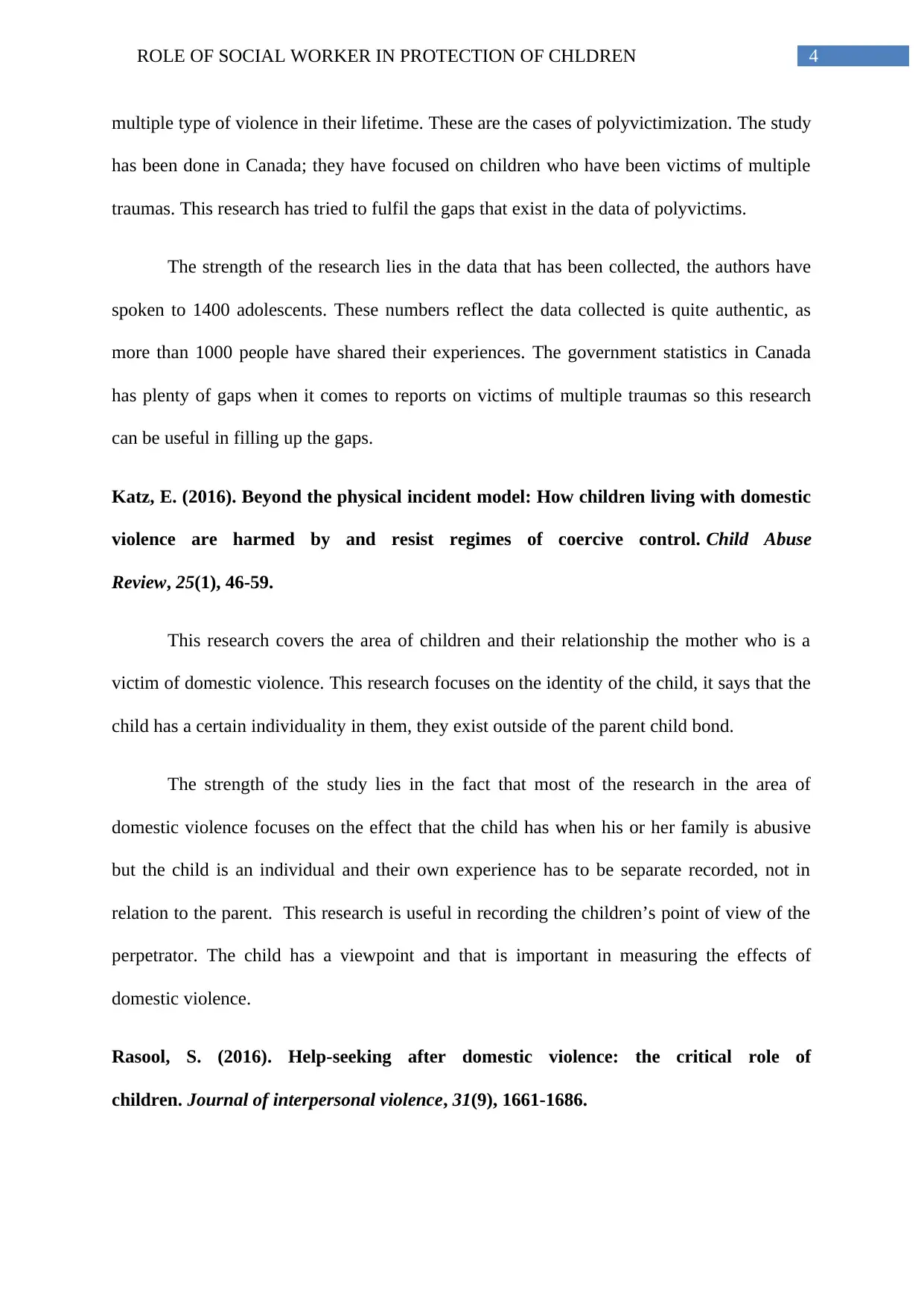
4ROLE OF SOCIAL WORKER IN PROTECTION OF CHLDREN
multiple type of violence in their lifetime. These are the cases of polyvictimization. The study
has been done in Canada; they have focused on children who have been victims of multiple
traumas. This research has tried to fulfil the gaps that exist in the data of polyvictims.
The strength of the research lies in the data that has been collected, the authors have
spoken to 1400 adolescents. These numbers reflect the data collected is quite authentic, as
more than 1000 people have shared their experiences. The government statistics in Canada
has plenty of gaps when it comes to reports on victims of multiple traumas so this research
can be useful in filling up the gaps.
Katz, E. (2016). Beyond the physical incident model: How children living with domestic
violence are harmed by and resist regimes of coercive control. Child Abuse
Review, 25(1), 46-59.
This research covers the area of children and their relationship the mother who is a
victim of domestic violence. This research focuses on the identity of the child, it says that the
child has a certain individuality in them, they exist outside of the parent child bond.
The strength of the study lies in the fact that most of the research in the area of
domestic violence focuses on the effect that the child has when his or her family is abusive
but the child is an individual and their own experience has to be separate recorded, not in
relation to the parent. This research is useful in recording the children’s point of view of the
perpetrator. The child has a viewpoint and that is important in measuring the effects of
domestic violence.
Rasool, S. (2016). Help-seeking after domestic violence: the critical role of
children. Journal of interpersonal violence, 31(9), 1661-1686.
multiple type of violence in their lifetime. These are the cases of polyvictimization. The study
has been done in Canada; they have focused on children who have been victims of multiple
traumas. This research has tried to fulfil the gaps that exist in the data of polyvictims.
The strength of the research lies in the data that has been collected, the authors have
spoken to 1400 adolescents. These numbers reflect the data collected is quite authentic, as
more than 1000 people have shared their experiences. The government statistics in Canada
has plenty of gaps when it comes to reports on victims of multiple traumas so this research
can be useful in filling up the gaps.
Katz, E. (2016). Beyond the physical incident model: How children living with domestic
violence are harmed by and resist regimes of coercive control. Child Abuse
Review, 25(1), 46-59.
This research covers the area of children and their relationship the mother who is a
victim of domestic violence. This research focuses on the identity of the child, it says that the
child has a certain individuality in them, they exist outside of the parent child bond.
The strength of the study lies in the fact that most of the research in the area of
domestic violence focuses on the effect that the child has when his or her family is abusive
but the child is an individual and their own experience has to be separate recorded, not in
relation to the parent. This research is useful in recording the children’s point of view of the
perpetrator. The child has a viewpoint and that is important in measuring the effects of
domestic violence.
Rasool, S. (2016). Help-seeking after domestic violence: the critical role of
children. Journal of interpersonal violence, 31(9), 1661-1686.
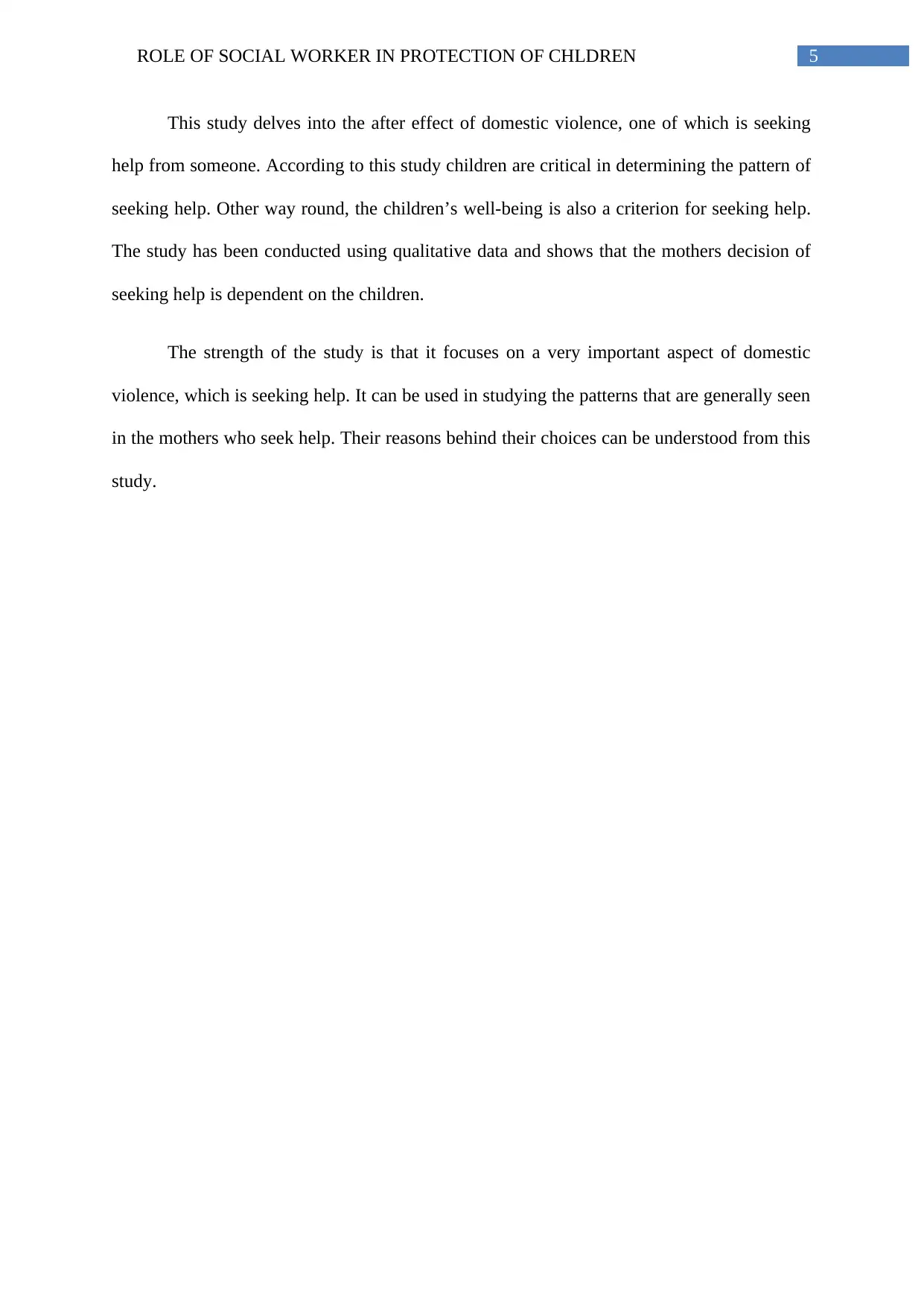
5ROLE OF SOCIAL WORKER IN PROTECTION OF CHLDREN
This study delves into the after effect of domestic violence, one of which is seeking
help from someone. According to this study children are critical in determining the pattern of
seeking help. Other way round, the children’s well-being is also a criterion for seeking help.
The study has been conducted using qualitative data and shows that the mothers decision of
seeking help is dependent on the children.
The strength of the study is that it focuses on a very important aspect of domestic
violence, which is seeking help. It can be used in studying the patterns that are generally seen
in the mothers who seek help. Their reasons behind their choices can be understood from this
study.
This study delves into the after effect of domestic violence, one of which is seeking
help from someone. According to this study children are critical in determining the pattern of
seeking help. Other way round, the children’s well-being is also a criterion for seeking help.
The study has been conducted using qualitative data and shows that the mothers decision of
seeking help is dependent on the children.
The strength of the study is that it focuses on a very important aspect of domestic
violence, which is seeking help. It can be used in studying the patterns that are generally seen
in the mothers who seek help. Their reasons behind their choices can be understood from this
study.
⊘ This is a preview!⊘
Do you want full access?
Subscribe today to unlock all pages.

Trusted by 1+ million students worldwide
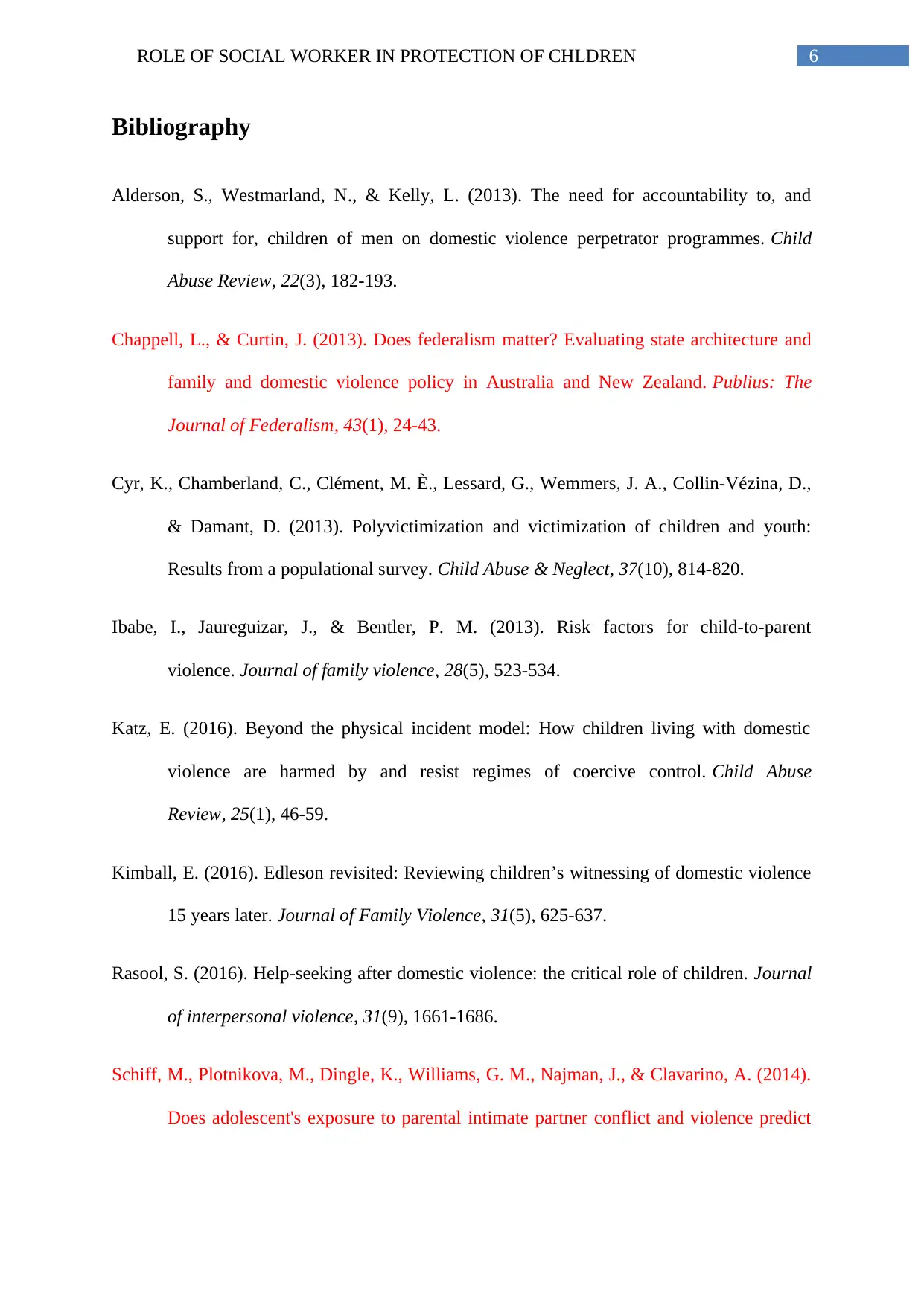
6ROLE OF SOCIAL WORKER IN PROTECTION OF CHLDREN
Bibliography
Alderson, S., Westmarland, N., & Kelly, L. (2013). The need for accountability to, and
support for, children of men on domestic violence perpetrator programmes. Child
Abuse Review, 22(3), 182-193.
Chappell, L., & Curtin, J. (2013). Does federalism matter? Evaluating state architecture and
family and domestic violence policy in Australia and New Zealand. Publius: The
Journal of Federalism, 43(1), 24-43.
Cyr, K., Chamberland, C., Clément, M. È., Lessard, G., Wemmers, J. A., Collin-Vézina, D.,
& Damant, D. (2013). Polyvictimization and victimization of children and youth:
Results from a populational survey. Child Abuse & Neglect, 37(10), 814-820.
Ibabe, I., Jaureguizar, J., & Bentler, P. M. (2013). Risk factors for child-to-parent
violence. Journal of family violence, 28(5), 523-534.
Katz, E. (2016). Beyond the physical incident model: How children living with domestic
violence are harmed by and resist regimes of coercive control. Child Abuse
Review, 25(1), 46-59.
Kimball, E. (2016). Edleson revisited: Reviewing children’s witnessing of domestic violence
15 years later. Journal of Family Violence, 31(5), 625-637.
Rasool, S. (2016). Help-seeking after domestic violence: the critical role of children. Journal
of interpersonal violence, 31(9), 1661-1686.
Schiff, M., Plotnikova, M., Dingle, K., Williams, G. M., Najman, J., & Clavarino, A. (2014).
Does adolescent's exposure to parental intimate partner conflict and violence predict
Bibliography
Alderson, S., Westmarland, N., & Kelly, L. (2013). The need for accountability to, and
support for, children of men on domestic violence perpetrator programmes. Child
Abuse Review, 22(3), 182-193.
Chappell, L., & Curtin, J. (2013). Does federalism matter? Evaluating state architecture and
family and domestic violence policy in Australia and New Zealand. Publius: The
Journal of Federalism, 43(1), 24-43.
Cyr, K., Chamberland, C., Clément, M. È., Lessard, G., Wemmers, J. A., Collin-Vézina, D.,
& Damant, D. (2013). Polyvictimization and victimization of children and youth:
Results from a populational survey. Child Abuse & Neglect, 37(10), 814-820.
Ibabe, I., Jaureguizar, J., & Bentler, P. M. (2013). Risk factors for child-to-parent
violence. Journal of family violence, 28(5), 523-534.
Katz, E. (2016). Beyond the physical incident model: How children living with domestic
violence are harmed by and resist regimes of coercive control. Child Abuse
Review, 25(1), 46-59.
Kimball, E. (2016). Edleson revisited: Reviewing children’s witnessing of domestic violence
15 years later. Journal of Family Violence, 31(5), 625-637.
Rasool, S. (2016). Help-seeking after domestic violence: the critical role of children. Journal
of interpersonal violence, 31(9), 1661-1686.
Schiff, M., Plotnikova, M., Dingle, K., Williams, G. M., Najman, J., & Clavarino, A. (2014).
Does adolescent's exposure to parental intimate partner conflict and violence predict
Paraphrase This Document
Need a fresh take? Get an instant paraphrase of this document with our AI Paraphraser
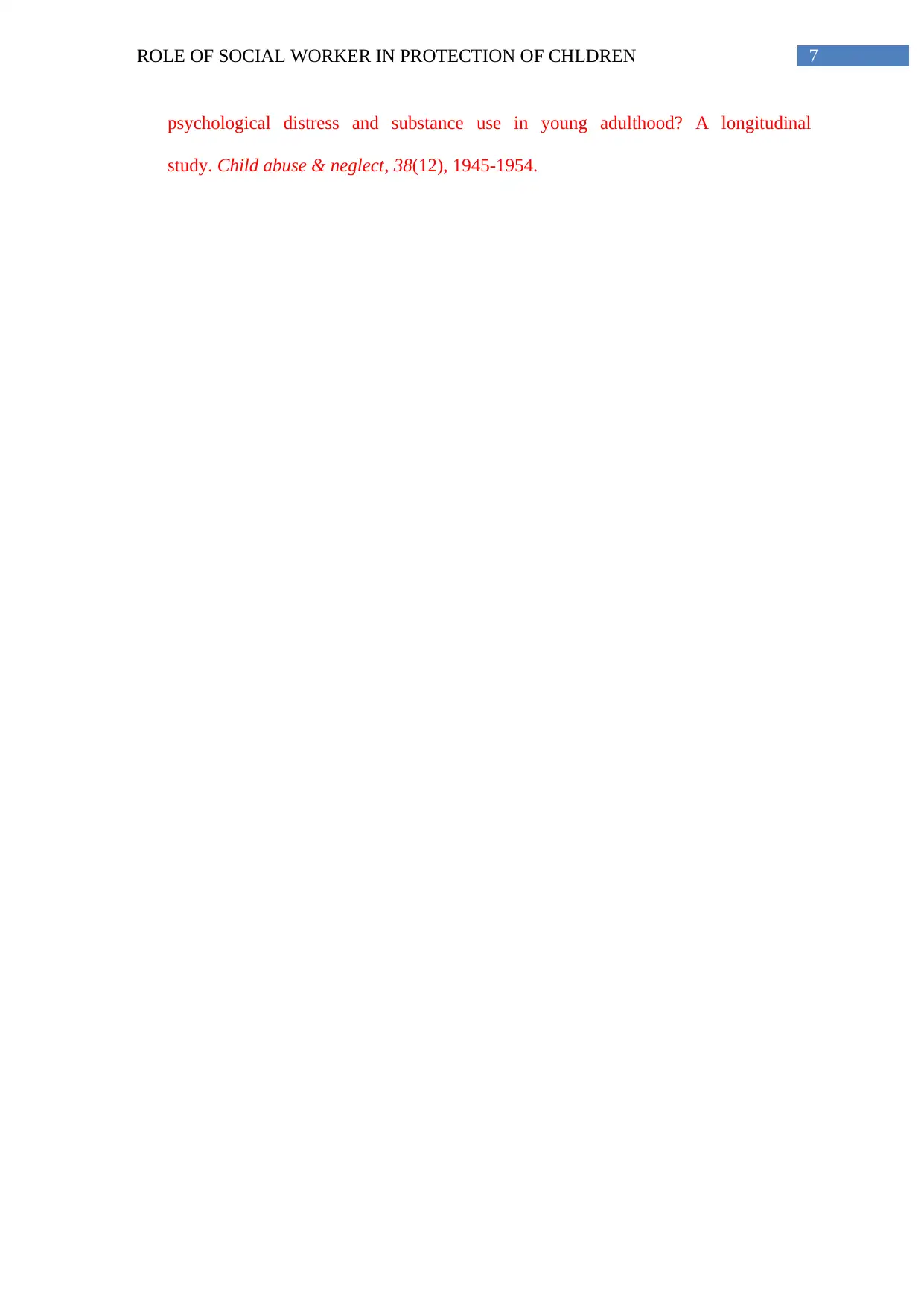
7ROLE OF SOCIAL WORKER IN PROTECTION OF CHLDREN
psychological distress and substance use in young adulthood? A longitudinal
study. Child abuse & neglect, 38(12), 1945-1954.
psychological distress and substance use in young adulthood? A longitudinal
study. Child abuse & neglect, 38(12), 1945-1954.

8ROLE OF SOCIAL WORKER IN PROTECTION OF CHLDREN
Abstract
This research proposal deals with the role of the social service providers in dealing with the
children who are the victims of domestic violence. The proposal has reviewed various
literature which has covered the work that has been done in the areas of domestic violence
and child protection. From the literature review, a gap was found in the area of the function
of the social worker in dealing with children of domestic violence. There a lot of research of
how the worker should behave but none of them clearly talk about the guidelines and
protocol that has to be followed. This research will try to find out a proper code of conduct
for the social worker. For this research the social workers will be interviewed and after the
data is collected is will be analysed to see how the function of the social worker can be
improved, what can be done to help the children who face domestic violence. A questionnaire
is also attached with the research which will help the researcher talk to the social workers
about their role.
Abstract
This research proposal deals with the role of the social service providers in dealing with the
children who are the victims of domestic violence. The proposal has reviewed various
literature which has covered the work that has been done in the areas of domestic violence
and child protection. From the literature review, a gap was found in the area of the function
of the social worker in dealing with children of domestic violence. There a lot of research of
how the worker should behave but none of them clearly talk about the guidelines and
protocol that has to be followed. This research will try to find out a proper code of conduct
for the social worker. For this research the social workers will be interviewed and after the
data is collected is will be analysed to see how the function of the social worker can be
improved, what can be done to help the children who face domestic violence. A questionnaire
is also attached with the research which will help the researcher talk to the social workers
about their role.
⊘ This is a preview!⊘
Do you want full access?
Subscribe today to unlock all pages.

Trusted by 1+ million students worldwide
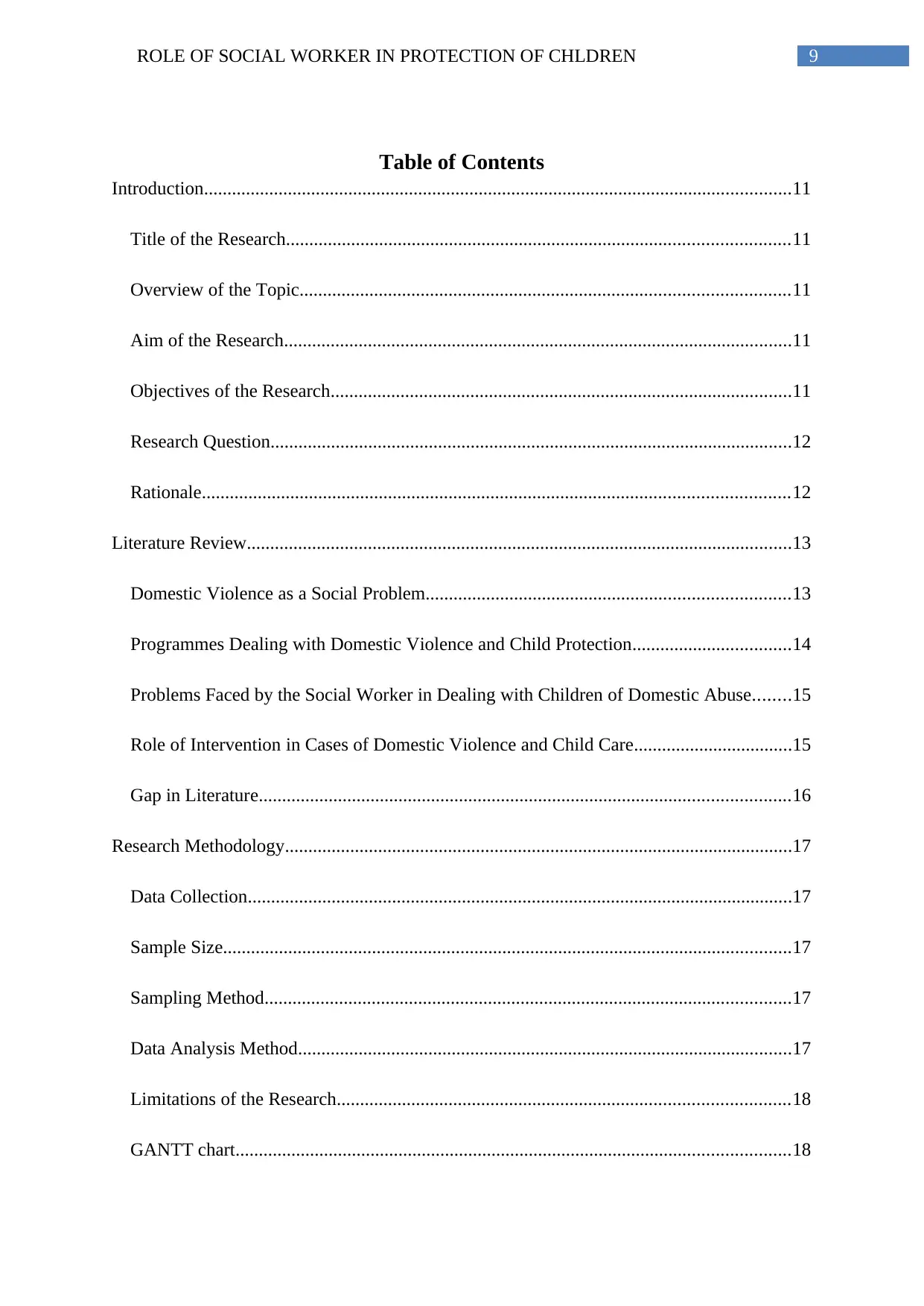
9ROLE OF SOCIAL WORKER IN PROTECTION OF CHLDREN
Table of Contents
Introduction..............................................................................................................................11
Title of the Research............................................................................................................11
Overview of the Topic.........................................................................................................11
Aim of the Research.............................................................................................................11
Objectives of the Research...................................................................................................11
Research Question................................................................................................................12
Rationale..............................................................................................................................12
Literature Review.....................................................................................................................13
Domestic Violence as a Social Problem..............................................................................13
Programmes Dealing with Domestic Violence and Child Protection..................................14
Problems Faced by the Social Worker in Dealing with Children of Domestic Abuse........15
Role of Intervention in Cases of Domestic Violence and Child Care..................................15
Gap in Literature..................................................................................................................16
Research Methodology.............................................................................................................17
Data Collection.....................................................................................................................17
Sample Size..........................................................................................................................17
Sampling Method.................................................................................................................17
Data Analysis Method..........................................................................................................17
Limitations of the Research.................................................................................................18
GANTT chart.......................................................................................................................18
Table of Contents
Introduction..............................................................................................................................11
Title of the Research............................................................................................................11
Overview of the Topic.........................................................................................................11
Aim of the Research.............................................................................................................11
Objectives of the Research...................................................................................................11
Research Question................................................................................................................12
Rationale..............................................................................................................................12
Literature Review.....................................................................................................................13
Domestic Violence as a Social Problem..............................................................................13
Programmes Dealing with Domestic Violence and Child Protection..................................14
Problems Faced by the Social Worker in Dealing with Children of Domestic Abuse........15
Role of Intervention in Cases of Domestic Violence and Child Care..................................15
Gap in Literature..................................................................................................................16
Research Methodology.............................................................................................................17
Data Collection.....................................................................................................................17
Sample Size..........................................................................................................................17
Sampling Method.................................................................................................................17
Data Analysis Method..........................................................................................................17
Limitations of the Research.................................................................................................18
GANTT chart.......................................................................................................................18
Paraphrase This Document
Need a fresh take? Get an instant paraphrase of this document with our AI Paraphraser
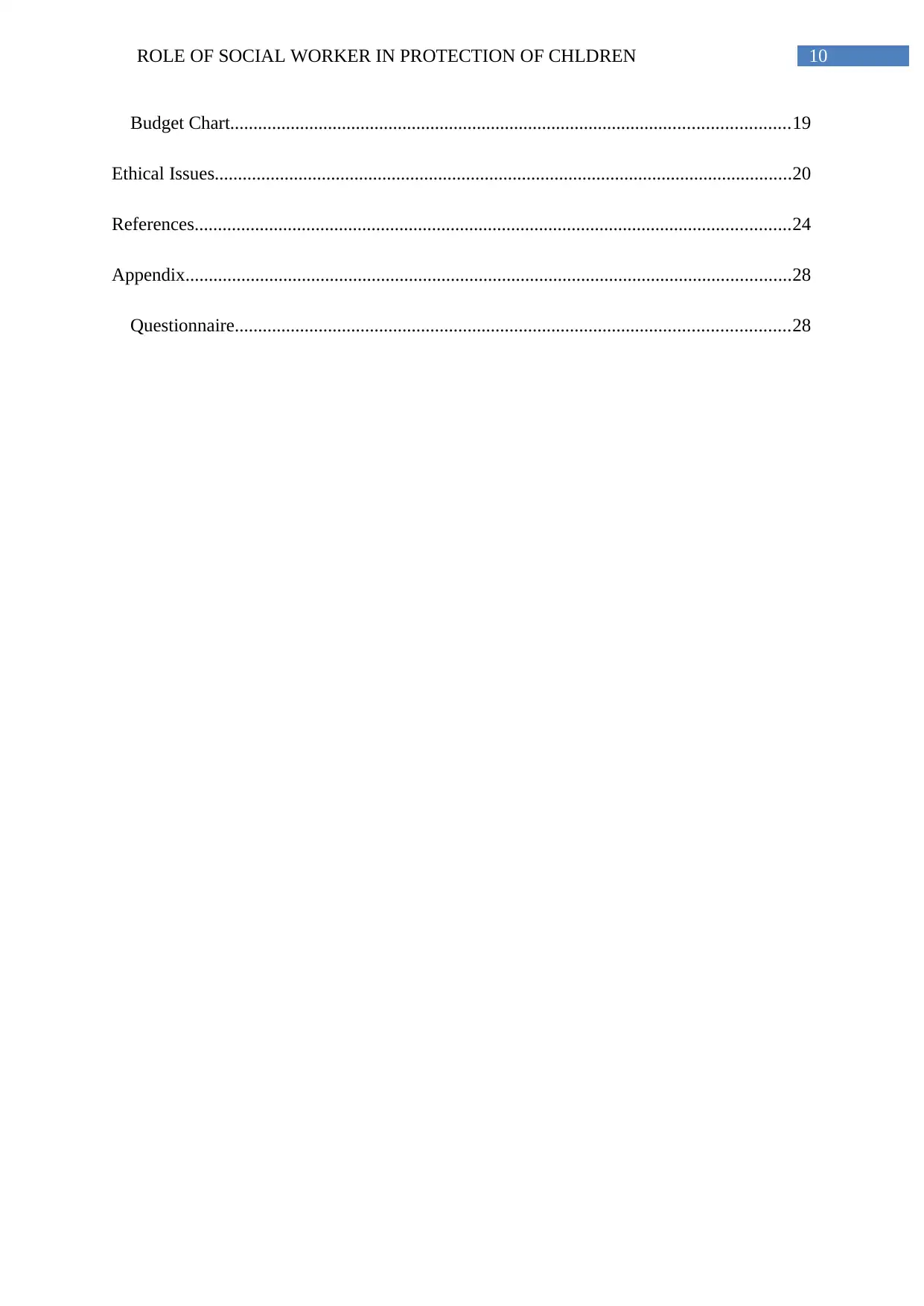
10ROLE OF SOCIAL WORKER IN PROTECTION OF CHLDREN
Budget Chart........................................................................................................................19
Ethical Issues............................................................................................................................20
References................................................................................................................................24
Appendix..................................................................................................................................28
Questionnaire.......................................................................................................................28
Budget Chart........................................................................................................................19
Ethical Issues............................................................................................................................20
References................................................................................................................................24
Appendix..................................................................................................................................28
Questionnaire.......................................................................................................................28
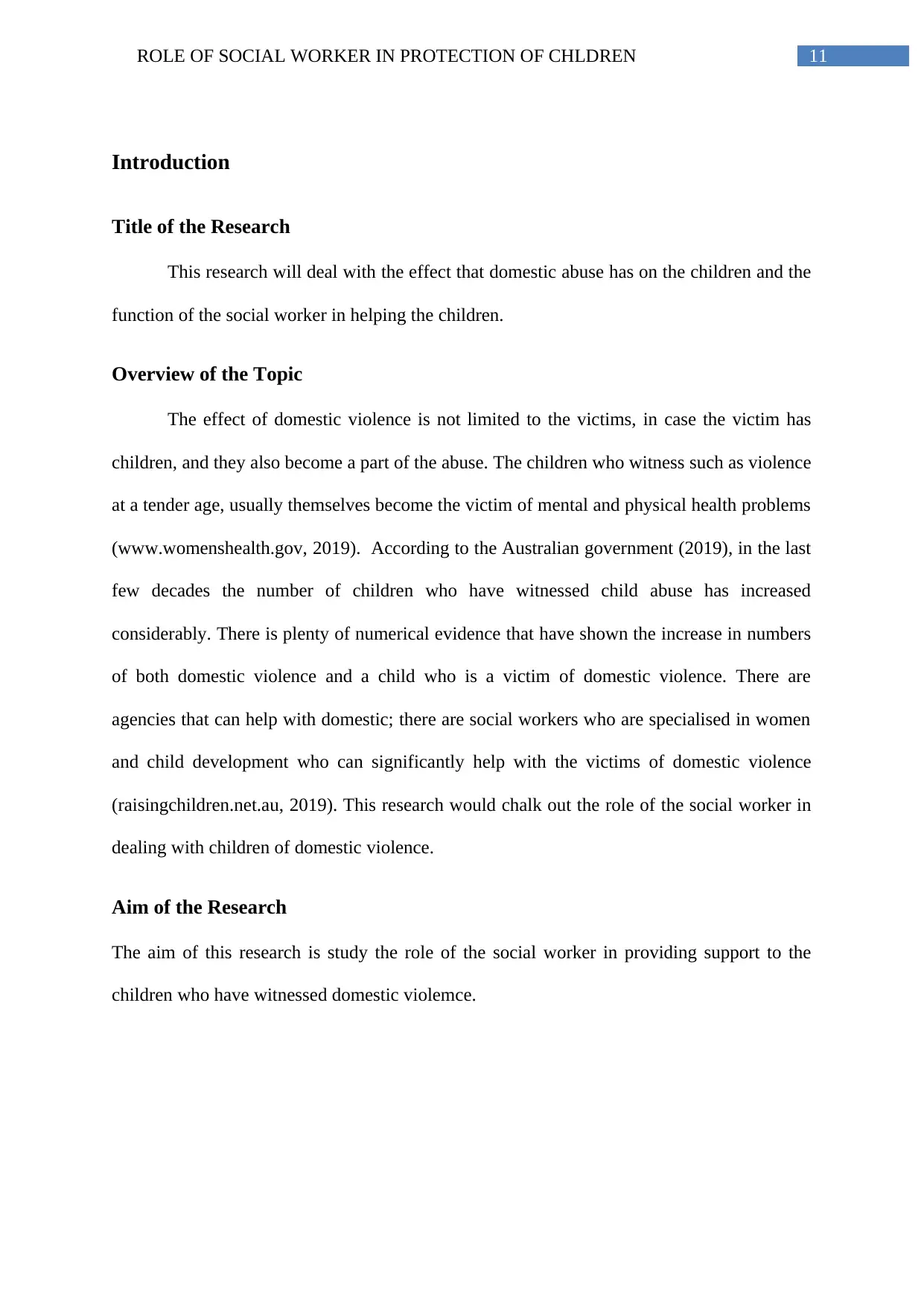
11ROLE OF SOCIAL WORKER IN PROTECTION OF CHLDREN
Introduction
Title of the Research
This research will deal with the effect that domestic abuse has on the children and the
function of the social worker in helping the children.
Overview of the Topic
The effect of domestic violence is not limited to the victims, in case the victim has
children, and they also become a part of the abuse. The children who witness such as violence
at a tender age, usually themselves become the victim of mental and physical health problems
(www.womenshealth.gov, 2019). According to the Australian government (2019), in the last
few decades the number of children who have witnessed child abuse has increased
considerably. There is plenty of numerical evidence that have shown the increase in numbers
of both domestic violence and a child who is a victim of domestic violence. There are
agencies that can help with domestic; there are social workers who are specialised in women
and child development who can significantly help with the victims of domestic violence
(raisingchildren.net.au, 2019). This research would chalk out the role of the social worker in
dealing with children of domestic violence.
Aim of the Research
The aim of this research is study the role of the social worker in providing support to the
children who have witnessed domestic violemce.
Introduction
Title of the Research
This research will deal with the effect that domestic abuse has on the children and the
function of the social worker in helping the children.
Overview of the Topic
The effect of domestic violence is not limited to the victims, in case the victim has
children, and they also become a part of the abuse. The children who witness such as violence
at a tender age, usually themselves become the victim of mental and physical health problems
(www.womenshealth.gov, 2019). According to the Australian government (2019), in the last
few decades the number of children who have witnessed child abuse has increased
considerably. There is plenty of numerical evidence that have shown the increase in numbers
of both domestic violence and a child who is a victim of domestic violence. There are
agencies that can help with domestic; there are social workers who are specialised in women
and child development who can significantly help with the victims of domestic violence
(raisingchildren.net.au, 2019). This research would chalk out the role of the social worker in
dealing with children of domestic violence.
Aim of the Research
The aim of this research is study the role of the social worker in providing support to the
children who have witnessed domestic violemce.
⊘ This is a preview!⊘
Do you want full access?
Subscribe today to unlock all pages.

Trusted by 1+ million students worldwide
1 out of 30
Related Documents
Your All-in-One AI-Powered Toolkit for Academic Success.
+13062052269
info@desklib.com
Available 24*7 on WhatsApp / Email
![[object Object]](/_next/static/media/star-bottom.7253800d.svg)
Unlock your academic potential
Copyright © 2020–2025 A2Z Services. All Rights Reserved. Developed and managed by ZUCOL.





